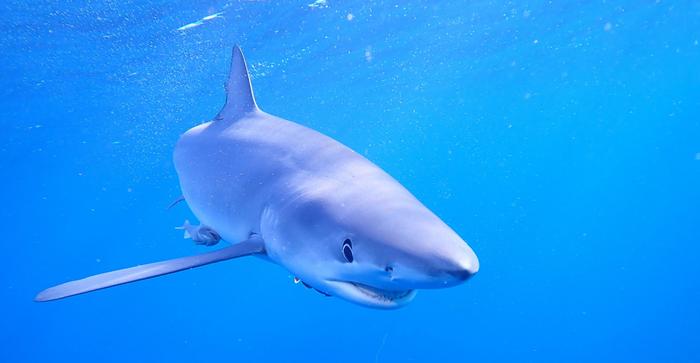(Santa Barbara, Calif.) — The ocean has hammerheads, sawsharks and even spadenose sharks. It seems there’s a shark for every task. Indeed, these predators each have specific roles to play in their ecosystems. A healthy ocean requires sharks of different shapes and sizes.

Credit: Neil Ferdinand Nathan
(Santa Barbara, Calif.) — The ocean has hammerheads, sawsharks and even spadenose sharks. It seems there’s a shark for every task. Indeed, these predators each have specific roles to play in their ecosystems. A healthy ocean requires sharks of different shapes and sizes.
Unfortunately, sharks’ diverse contributions are under threat from overfishing, climate change, habitat loss, coastal development, shipping activities and more. That’s why an international team of scientists contend that shark conservation must go beyond simply protecting shark populations — it must prioritize protecting the ecological roles that sharks fill. These findings come from a study published in Science that sheds new light on the role sharks play in healthy oceans, and why size should be a factor in conservation decisions.
The largest individuals of apex species like tiger sharks and great whites play an oversized role in healthy oceans. But they are often the most affected by fishing. Big sharks help maintain balance through their eating habits. Sometimes their sheer size is enough to scare away prey that could over-consume seagrass and other plant life needed for healthy oceans.
“Despite the fact the sharks are well recognized and appreciated in popular media and lore, their importance in maintaining ecosystem health was understudied and underappreciated,” said co-author Jennifer Caselle, a marine biologist at UC Santa Barbara. “We show that sharks are critical components to ecosystem function, making their global population declines particularly worrisome. Conservation measures to protect sharks are urgently needed.”
Besides playing critically important roles within the food web, reef sharks feed in offshore waters and bring nutrients back to the reef. Others move around nutrients that are used at the base of the food chain. Sharks can also serve as food for other species and even as scratching posts for fish to remove parasites. The problem is that shark abundance, for oceanic species, has plummeted by 71% in the past 50 years. Populations of the top five reef shark species have declined by 63%. As their numbers nosedive, their important roles in ocean health are also lost.
“It’s time to have a conversation about everything sharks are doing to maintain ocean health so we can better prioritize conservation efforts and have the biggest impact,” said lead author Simon Dedman, a researcher at Florida International University, which led the study team.
The researchers built upon a variety of datasets and previous studies to estimate global shark population trends. For instance, former UCSB doctoral student Erin Dillon discovered that she could use fossil shark scales excavated during digs in prehistoric reefs in the Caribbean to estimate the region’s shark populations. The shape and prevalence of different shark scales enabled her to estimate the type and abundance of sharks going back almost 6,000 years. By comparing data from multiple sites in this new report, she was able to document that shark abundance in the region declined by approximately 70% since prehistoric times.
Fortunately, it is not bad news for all sharks. There are a few promising instances where smart and responsible management appears to be helping sharks — and the jobs they perform in nature — to recover. Co-author and UCSB professor Douglas McCauley, who studies white sharks in Santa Barbara using drones and AI, cites their situation as a hopeful example. In addition to laying out a roadmap to see more such shark success stories, this new research also provides advice on how we can share our ocean backyards with sharks. “We’ve learned a lot about how to co-exist with ecologically important species that we’ve brought back on land, like bears and wolves, that can help us better share space with these recovering ocean wildlife,” he said.
The issue of shark conservation becomes all the more critical as global temperatures increase, leading some sharks to head into new areas where they can find the temperatures they can thrive in.
“This study verifies what we’ve long suspected – sharks are critical to ocean health,” said Lee Crockett, executive director of the Shark Conservation Fund, which funded the study. “This landmark study serves as confirmation that marine conservationists, philanthropists, policymakers and the public alike need to recognize that sharks are keystone species that have a now-proven significant effect on marine environments.”
With the expansion of blue economy industries like aquaculture and tourism, people’s encounters with sharks will likely increase. Finding a balance that protects the sharks most needed for healthy oceans is hitting a critical point.
“National and international policy must focus on actions that rebuild populations and restore sharks’ functional roles,” said Mike Heithaus, study co-author and FIU marine ecologist. “That requires action to increase both spatial measures like marine protected areas and fisheries management measures like catch/size limits and gear limitations. If people want healthy oceans, we need healthy shark populations.”
Journal
Science
Article Title
Ecological roles and importance of sharks in the Anthropocene Ocean
Article Publication Date
2-Aug-2024



